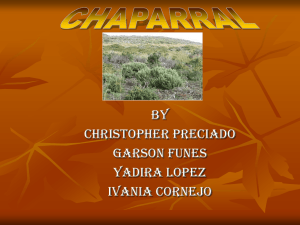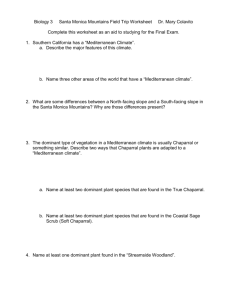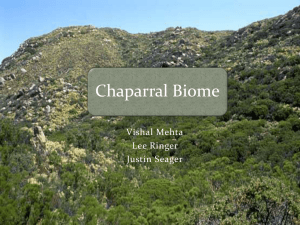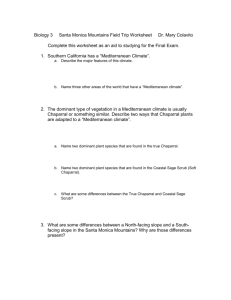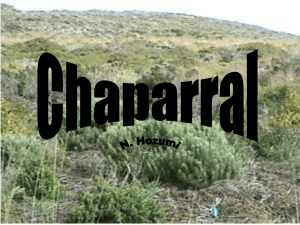The Chaparral - Mercer Island School District
advertisement
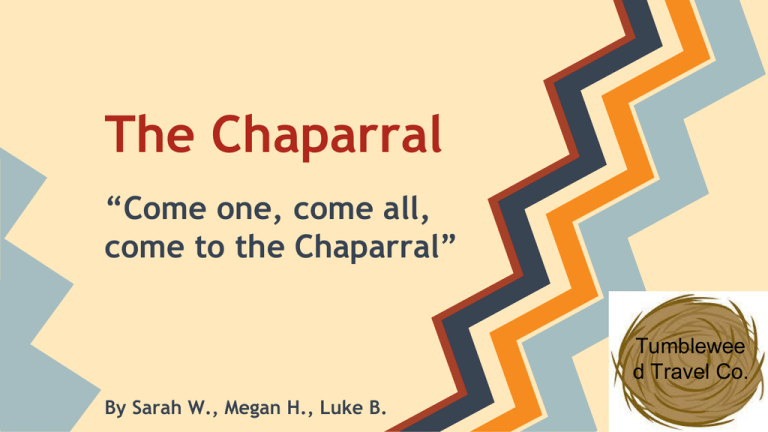
The Chaparral “Come one, come all, come to the Chaparral” Tumblewee d Travel Co. By Sarah W., Megan H., Luke B. Some people say that the only way one can live in the Chaparral is if you carry a fire extinguisher and have home insurance. However, there is much more to the Chaparral than fire and destruction... The California Chaparral “Dominating foothills and mountain slopes from the Rogue River Valley in southern Oregon to the San Pedro Martir in Baja California. Chaparral provides the deep green backdrop for Santa Barbara, the soft hues surrounding the gold country along the western slopes of the Sierra, and a valuable wilderness retreat for a rapidly growing San Diego. Take a drive into the hills surrounding nearly every southern California metropolitan area and you are immediately immersed in chaparral” Chaparral locations Chaparral Locations ● Coastal regions that border deserts ● Central Chile = matorral ● Western Australia = kwongan ● South Africa = called Fynbos (fain-boos) ● Mediterranean Region=Maquis Description of Chaparral ● A special plant community characterized by drought hardy, woody shrubs, shaped by a Mediterranean-type climate (summer drought, winter rain), and threatened by too many fires. Plants of the Chaparral Blue Oak Adaptation: extensive root system allows it to find water Mountain Mahogany Adaptation: it dwarves when there is a severe drought Plants of the Chaparral Manzanita Adaptation: the plant germinates by fire Chamise Adaptation: the blossoms sprout after fire Plants of the Chaparral Scrub Oak Adaptation: resprout from basal burls after a burn Silk-tassel Bush Adaptation: grows the best in little sun and infrequent watering Animals of the Chaparral ● adaptations required to survive in the Chaparral o unique fur with the ability to adjust with wide temperature ranges o ability to cope with sparse and rough terrain (less of a need for food and water) the ability to ration due to long droughts o nocturnalism to avoid the harsh heat during the day o usually small in size because of the short plants o ability to consume and digest plants from rough, shrubbish terrain Animals of the Chaparral Black-Tailed Jack Rabbit Cactus Wren Animals of the Chaparral Puma Wild Goat Animals of the Chaparral Spotted Skunk San Joachin Kit Fox Seasons and Climate of the Chaparral ● Winter: mild and moist, but not rainy ● Summer: very hot and dry o wide temperature range: 30-100 degrees fahrenheit ● mid-altitude climate, with westerly winds (which is why chaparral biomes tend to be on the west coast of continents Temperature and Precipitation The Chaparral area receives about 10-17 inches of precipitation a year. Visiting Times Winter/Spring: This season is perfect for your shrubbery viewing pleasure. The cool days provide an optimum setting for hiking excursions and catching glimpses of sprouting Chaparral plants. Come catch the scenery before it catches on fire! Activities ● Sightseeing tours: o o o Wildlife oceanic views Western movie film locations ● Nightlife: o o Observe nocturnal species Witness wildfires burn the entire biome and light up the night sky! ● Hike in a globally unique, emblematically Californian landscape Unique Features of the Chaparral ● the chaparral is adapted to and maintained by fires o many of the shrubs store food reserves in their fire-resistant roots and produce seeds that sprout only after a hot fire. o with the first rain, annual grasses and wildflowers spring up and use nutrients released by the fire → new shrubs grow quickly and crowd out the grasses. Environmental Issues ● lumberjacks are cutting down trees and destroying vegetation ● humans kill animals, which disrupt the food chain ● commercial building ● fires started by humans o people feel that this is necessary in order to preserve the biome, this is false. The Chaparral is waiting...


